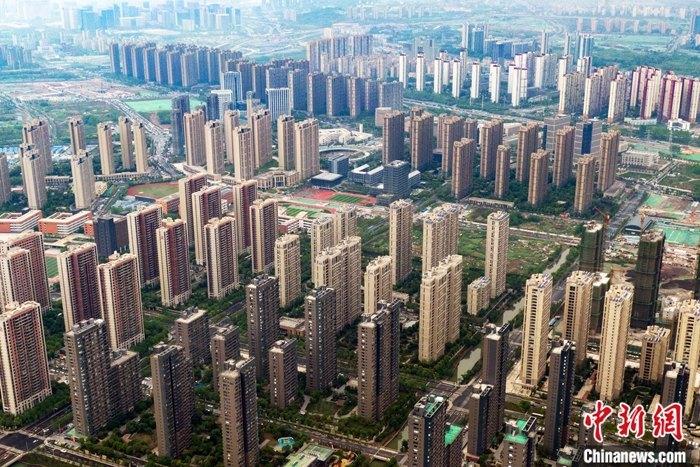China News Service, Beijing, December 14 (Reporter Pang Wuji) Housing prices in China's large and medium-sized cities continue to cool down.
According to data released by the National Bureau of Statistics of China on the 14th, in November, among China's 70 large and medium-sized cities, 36 cities saw a month-on-month increase in the sales prices of new commercial residential buildings, 6 cities remained unchanged and 28 cities fell.
The number of cities where housing prices fell month-on-month hit a new high since November 2015, and the number of cities where housing prices rose month-on-month was the lowest since February this year.
The data picture shows an aerial photograph of a real estate in Yuhuatai District, Nanjing on April 17.
Photo by China News Agency reporter Yang Bo
While the number of cities with rising housing prices has decreased, the increase in housing prices in 70 large and medium-sized cities has continued to narrow.
Yan Yuejin, research director of the Think Tank Center of the E-House Research Institute, pointed out that according to estimates, the price index of newly built commercial housing in 70 cities across the country rose 0.1% month-on-month and 4.0% year-on-year in November.
As of the current month, the month-on-month increase in house prices has narrowed for three consecutive months, and the year-on-year increase has narrowed for five consecutive months, indicating a cooling trend in house prices.
Looking at it by line, Sheng Guoqing, chief statistician of the City Department of the National Bureau of Statistics, pointed out that the month-on-month increase in the sales prices of new commercial housing and second-hand housing in the first, second, and third-tier cities was the same as the previous month or fell back.
Taking first-tier cities as an example, in November, the sales prices of newly-built commercial residential buildings in four first-tier cities increased by 0.2% month-on-month, and the increase was 0.1% lower than the previous month.
Xu Xiaole, chief market analyst at the Shell Research Institute, believes that the reason for the narrowing of house prices in November is mainly related to the degree of credit easing.
With the gradual return of monetary policy to neutrality, the loose housing credit environment bottomed out. In the second half of the year, the loan market quoted interest rate (LPR) remained unchanged. The 36-city mainstream housing loan interest rate monitored by the Shell Research Institute slowed down and stabilized. Residential housing loans The balance growth rate continued to decline.
At the same time, cities where housing prices have risen in the previous period have also strengthened financial supervision, effectively curbing speculative house purchases.
Xu Xiaole said that since late November, the control density has increased again.
In the medium and long term, real estate regulation will continue the basic tone of housing housing and non-speculation, stabilize housing price fluctuations, continue to deepen housing financial regulation, and strictly control the leverage at both ends of supply and demand, and the momentum of housing price increases will be further weakened.
Xie Chen, head of the research department of CB Richard Ellis China, also pointed out that since the second half of the year, some first- and second-tier cities with signs of overheating have begun to upgrade their control measures accordingly. At the same time, new financing regulations for housing companies will also be implemented next year, which is expected in 2021. The overall property market policy will be slightly tightened compared to this year, and "do not speculate on housing, and implement policies based on the city" is still the main tone. He predicts that next year's housing prices will continue to be stable. (Finish)

